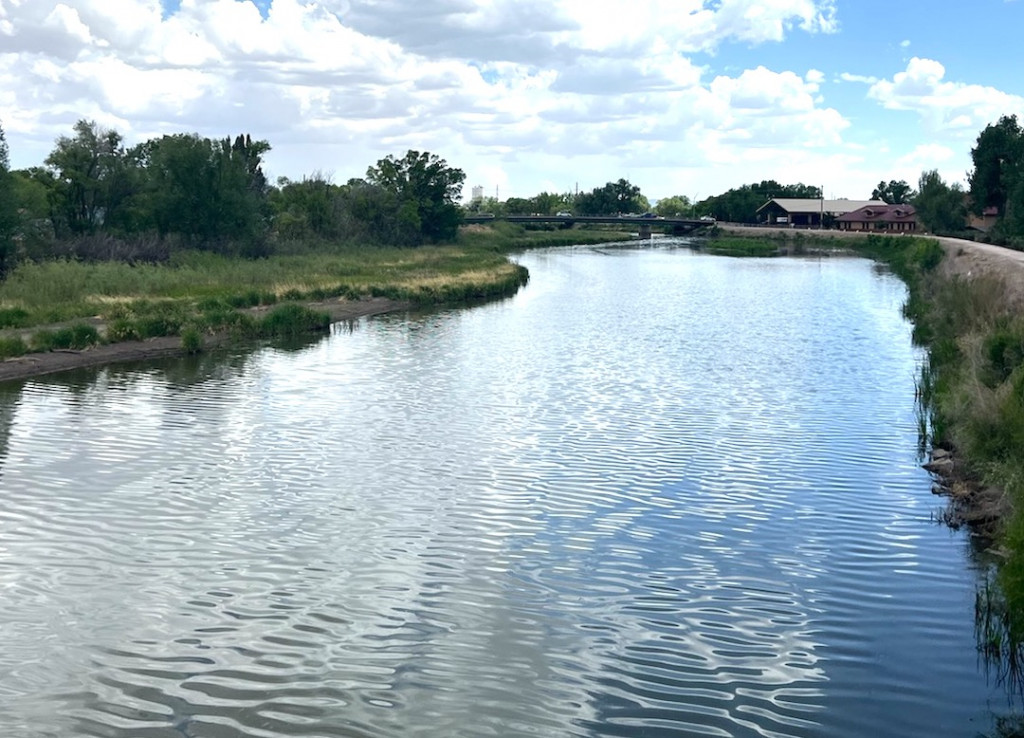Drought impacts water rights on Rio Grande

How to adapt without fundamentally changing?
VALLEY– For more than two decades, leaders in the local agricultural community have warned of the inevitability of less and less water being available for the irrigation of crops in the San Luis Valley.
As the current drought continues to persist, even those not engaged in farming or raising livestock can read the headlines or look at maps that show large swaths of the valley blanketed in colors indicating extreme drought. Yet, there are moments when the stark reality of those warnings becomes abundantly clear.
One of those moments occurred this week.
In a conversation held on Thursday with the Valley Courier, Cleave Simpson, general manager for the Rio Grande Water Conservation District, shared a sobering fact. “As of today, a water right adjudicated on the Rio Grande River in 1871 is the last water right being served on the river.”
Water rights in Colorado are based on the prior appropriation doctrine, otherwise known as “first-in-time, first-in-right.” Those with the oldest, and therefore most senior, appropriations of water have priority over other younger, or more junior, water rights.
In this case, those whose water rights were decreed in or before 1871 will have access to water from the Rio Grande. All those with water rights issued after 1871 up to 1959, the last year a new appropriation was made on the river, will not be able to use water from the river this season unless more rain falls.
“We’re not even at the end of June yet, and we are way down on the appropriation list,” Simpson said. “If you’re already down to turning off water that was appropriated after 1871, this is an ugly set of circumstances.”
The drought of 2002 was the worst drought in recorded history and is the standard by which other periods of drought are measured. “We’re not on pace with 2002 but we’re pretty bad,” Simpson said.
He speaks from experience. In 2002, Simpson had to ship his cows to calve in Missouri, which he described as a “disaster in itself.” While conditions today are not quite as extreme, there are similarities to what happened twenty years ago.
“People who rely on just surface water will be faced with choices. Sell your herd or be prepared to buy hay to feed their cows. But it’s going to be impossible to buy hay to feed cows this year from an economic standpoint. Those prices are going to be high because everyone is experiencing such a drought. And people who have wells to back up their supply, those resources are being stressed. You can see it in the unconfined aquifer very readily every day. Look on our website and you can see the levels go down. We just don’t have the water resources that we’ve had in the past, and we can’t keep pumping the way we’ve been.”
While farmers and ranchers will be facing tough choices soon, Simpson – whose approach is consistently equal parts recognition of a challenge and search for the solution – is also focused on the larger questions that extend beyond this growing season.
“How do we adapt and change without fundamentally changing what we look like and what drives our economy, culture and community? We’re trying to do this very thoughtfully and incrementally. I think, without a doubt, there is going to be less irrigated acres here than historically there has been.
“And, for me, I’ve been focusing a lot of time and energy on is there a path here for renewable energy. Can solar energy fill some of that gap? There are tremendous hurdles in that space of trying to make that a reality. Of course, I don’t want to see fifty-thousand acres of solar panels but there’s certainly room for some here, and I think it could fill that economic void that will come from taking out some irrigated acres.”
Without going into much detail, Simpson mentioned some recent “small wins” but recognizes it is going to take a collaborative, concerted effort to make the gains that, he feels, may hold promise.
“Interest is growing,” he said. “And the timing couldn’t be much better. The state wants to be carbon free. Xcel wants to be carbon free. Tri-state wants to be carbon free. It feels like there’s momentum and the San Luis Valley would be the premier place for more
solar. It’s just a matter of getting the right people in the right place at the right time. There are a handful of us who are working toward that.”
Simpson said another economic piece relates to changing crops that are grown. Personally, he is contracted with a local processor to raise 50 acres of industrial hemp, largely driven by the water scarcity that makes farming “harder and harder.”
Historically, the valley raises about 150,000 acres of alfalfa and other hay. If Simpson can raise hemp with the same success he has raising alfalfa, he estimates it would cut his water consumption by half.
But the potential reward hemp can bring goes hand in hand with challenges with processing and marketing, a situation where Simpson reports being “really excited about hemp at times and really frustrated at other times.”
Everything must be considered, he says, including co-ops, value added crops, diversification, resiliency. There is also potential in conservation easements on aquifers, as Colorado Open Lands is currently discussing with farmers.
“It’s not a disaster yet,“ he said and then stopped, trying to remember a quotation to address how he sees things. He settled for paraphrasing. “Things happen as a result of catastrophe or thoughtful leadership.”
The best option, in Simson’s view, is to choose the latter.



